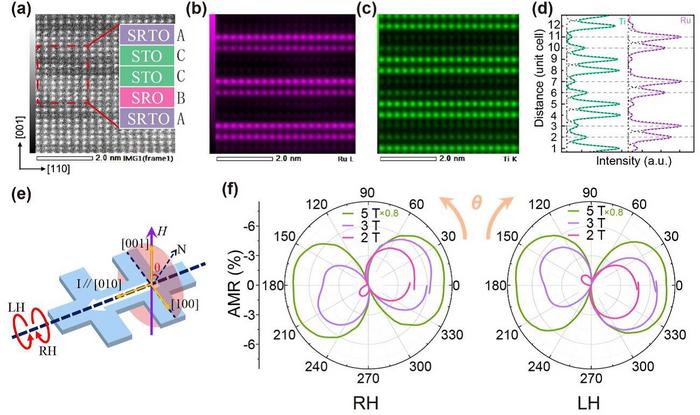In the realm of condensed matter physics, chirality—the property of an object being distinguishable from its mirror image—has long captivated researchers for its profound implications across disciplines, from molecular biology to advanced materials science. Recently, a team of physicists at ShanghaiTech University has unveiled a groundbreaking discovery in the manipulation of chiral electromagnetic phenomena within engineered oxide superlattices, marking a significant leap forward in the understanding and application of magneto-chiral effects in complex materials. Their findings, published in Science Bulletin, reveal an angle-resolved electrical magneto-chiral effect, enabled through the precise construction of SrRuO₃-based heterostructures with broken inversion symmetry.
Chirality in inorganic materials manifests distinctively, influencing electron transport behaviors under magnetic fields in ways previously observed primarily at molecular or nanoscale levels. For instance, chiral carbon nanotubes exhibit anisotropic electrical conductivity responsive to magnetic field orientation, a phenomenon highlighting how structural asymmetry guides electron dynamics. Extending this concept to oxides with intrinsic magnetic properties presents unique challenges and opportunities, particularly when considering the interplay of electron correlations, spin exchange interactions, and, crucially, spin-orbit coupling effects.
Magnetic oxides such as SrRuO₃ are known for their complex balance of electron correlation and spin exchange interactions, which shape their magnetic ordering and transport properties. Introducing strong spin-orbit coupling in these materials further diversifies their physical behaviors, giving rise to emergent phenomena like Rashba-type spin splitting and Dzyaloshinskii-Moriya interactions (DMI). While the Rashba interaction has been extensively studied in oxide interface two-dimensional electron gases—producing measurable electromagnetic chiral effects—the in-depth exploration of DMI’s contribution to magneto-chiral behavior remains a formidable experimental and theoretical frontier due to its subtle and direction-dependent nature.
The researchers at ShanghaiTech innovatively fabricated superlattices comprising SrRuO₃, SrRu₁₋ₓTiₓO₃, and SrTiO₃ layers arranged in a novel A-B-C-C stacking sequence. Utilizing laser molecular beam epitaxy, a technique allowing atomic-layer precision in constructing heterostructures, they engineered a deliberate breaking of inversion symmetry essential for realizing pronounced chiral responses. This architectural control endowed the material with a finely tunable Dzyaloshinskii-Moriya interaction, acting as a microscopic source of asymmetric spin interactions that influence the macroscopic electromagnetic behavior.
Their experimental approach involved rotating these carefully constructed superlattice samples within an external magnetic field while performing precise electrical resistance measurements. Intriguingly, the direction corresponding to the minimum resistance—indicative of the magnetic easy axis orientation—exhibited distinct left-handed and right-handed rotational modes. This handedness-dependent rotational symmetry demonstrates a direct link between the engineered chiral atomic stacking and the emergent macroscopic magneto-chiral phenomena, a signature that had remained elusive in oxide heterostructures.
One of the most compelling aspects of their discovery is the magnitude of the angular rotation; the maximum rotation angle of the magnetic easy axis reached up to 45 degrees, a remarkably large value uncommon in similar systems. This provides unequivocal evidence for the effective control of spin textures via interfacial DMI and magnetic anisotropy engineering. The ability to induce such a semi-self-controlled rotation opens avenues for precise manipulation of spin configurations, crucial for future spintronic devices aimed at higher efficiency and lower power consumption.
Unlike traditional magneto-chiral effects that are typically constrained to configurations where currents flow strictly parallel or antiparallel to the applied magnetic field, the effect demonstrated here transcends these limitations. The observed ‘semi-self-controlled’ rotational behavior suggests that the superlattice can discern not only the directional vector of an external magnetic field but also resolve its intensity. This dual sensitivity enhances the functional versatility of these materials, positioning them as potential candidates for novel magnetic sensors and advanced information processing technologies.
Fundamentally, the study illuminates how engineered Dzyaloshinskii-Moriya interactions within oxide superlattices provide a rich platform for exploring non-trivial spin-dependent transport phenomena. As inversion symmetry is locally broken at interfaces, and spin-orbit coupling intertwines with magnetic exchange, emergent chiral behaviors can be induced and manipulated at will. This contrasts with bulk materials, where such subtle effects are often averaged out or suppressed by higher symmetries.
The implications of this research extend beyond fundamental physics into the rapidly evolving field of spintronics, where the electron spin degree of freedom is harnessed for next-generation electronic devices. The demonstrated angle-resolved magneto-chiral effect could enable devices capable of operating based on magnetic field angle detection, offering prospects for ultra-sensitive magnetic memory elements, tunable spin filters, and logic devices with integrated directional control.
Moreover, the methodology employed—layer-by-layer atomic precision growth paired with detailed transport measurements under variable magnetic fields—establishes a robust experimental framework for investigating other exotic phases where chirality and spin-orbit coupling interplay. The findings encourage further exploration into related transition metal oxides and engineered heterostructures to tailor magneto-electric coupling phenomena, potentially unveiling new quantum states and functionalities.
In conclusion, the angle-resolved electrical magneto-chiral effect realized within SrRuO₃-SrRu₁₋ₓTiₓO₃-SrTiO₃ superlattices represents a significant advancement in the manipulation of chiral spin interactions via artificial symmetry breaking. By harnessing the Dzyaloshinskii-Moriya interaction and precise layer stacking, this research unlocks unprecedented control over magnetic anisotropy and electron transport in oxide materials. This breakthrough not only broadens the fundamental understanding of magneto-chiral phenomena but also paves the way for transformative applications in spintronics and magnetic sensor technologies.
Subject of Research: Angle-resolved electrical magneto-chiral effect in oxide superlattices; Dzyaloshinskii-Moriya interaction engineering; spintronics.
Article Title: Angle-resolved Electrical Magneto-Chiral Effect Demonstrated in SrRuO₃-SrRu₁₋ₓTiₓO₃-SrTiO₃ Superlattices with Broken Inversion Symmetry.
Web References: DOI:10.1016/j.scib.2025.03.021
Image Credits: ©Science China Press
Keywords
Chirality, Magnetic fields, Oxides, Discovery research, Atomic structure, Spintronics, Electronic devices, Electrical conductivity, Electron spin




